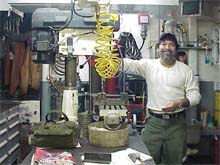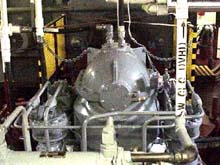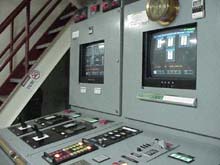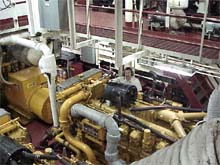
Gordon, an engineer on the NOAA Ship Ronald H. Brown, shows the shop where almost anything the ship needs can be made. All of the engineers are proficient in skills such as welding and torching, and know how to work on parts of the engine in case of emergencies. Click image for larger view.
We are the Ronald H. Brown–
The Engine Room
September 2, 2002
Lisa M. Weiss, Watershed Coordinator
Jacques Cousteau National Estuarine Research Reserve
The engine room is the “brains of the ship," according to the men who work here. From here, fresh water flows, electricity is supplied, pumps that flush the toilets are maintained, and, most importantly, the motors are kept running. Without the ship's engineers, we never would have left the dock in Miami.
Gordon, one of the engineers, started by explaining the ship's forward thrusters. This is a large generator and motor with giant blades that controls the ship from side to side (left to right). Controlled on the bridge by the auto positioning system, the forward thruster is enabled when the Ron Brown enters or exits a port, or when the ship has to "sit on station" (remain in place) such as when the researchers make a CTD cast to collect water samples.

One of the two main motors aboard the Ron Brown. Much like an outboard motor, they consist of engines and generators. This type of motor is known as a Z-drive. Click image for larger view.
Next, he moved onto the MG-sets, otherwise known as the motor generator sets. These machines take the “dirty” electrical power and and "clean it up” so that there are no spikes or power surges when the electricity goes back out to various parts of the ship.
Next, he moved into the main control room. Here, the engineers can take control of the ship from the bridge in case of an emergency. They have control of the generators that propel the ship forward. They keep track of the “ship’s service,” which Gordon explained consists of the features of the ship that make it like a hotel: the pumps and the lighting, the air conditioning and the running water. The main control room also has monitors with gauges that let them know how much fuel is in each one of the fuel tanks, and how much fuel has been burned hour by hour and day by day. The Ron Brown can safely hold 253,851 gal of fuel. Since a standard car holds about 15 gal, the ship holds enough fuel to fill up nearly 17,000 automobiles!

The main controls, as seen here, and the navigational bridge are the two locations from which the ship and its movements can be controlled. Here at the main controls, electronic gauges tell the engineers important information such as the amount of fuel in each of the tanks. Click image for larger view.
The Ron Brown has two 16C and two 8C diesel engines for its propulsion and electrical service needs. Usually, the 16C engines are used for the ship's movements, and the smaller engines are used for service needs. All engines can be used if necessary, however, to assist the ship in its movements. If one engine is shut down for any length of time, and the engineers want to add power from a second engine, they must bring the second engine up to the appropriate power. This process is known as “paralleling the engines."
Other parts of the engine room tour included the winch control room, the carbon-dioxide tanks, which would be used to help control a large fire in the engine room, and the 50-ton and 110-ton air-conditioning units. The ballast control valves allow the engineers to control the amount of water that flows into and out of the ship’s ballast, which is the weight located at the very bottom of the ship that helps to keep it "righted."

First engineer Brian Mitchell at work in the engine room of the Ron Brown. All the machinery that makes up the engine room is located in the very bottom of the ship, also known as the "bowels" of the ship. It is through the work of the engineers that the ship has air conditioning, flushing toilets, lighting, electrical power and working motors. Click image for larger view.
As explained by Gordon and the other engineers aboard the Ron Brown, the engineers are the people who make the washer and dryer possible and the refrigerator and the freezers possible. The engine room supplies hot water to the showers, electricity to power the researchers' sea-floor mapping equipment, and the air conditioning that keeps everyone comfortable inside. Most importantly, the engineers work round-the-clock to ensure that the Ron Brown is functioning properly, steaming along the next trackline, or holding at one station so that the team can take a water- column sample. These fellows work at the very bottom of the ship, and are rarely seen except at mealtimes or when they visit the deck for a breath of fresh air. Working as they do, quietly and behind the scenes, the ship's engineers make this entire expedition possible.
Sign up for the Ocean Explorer E-mail Update List.























